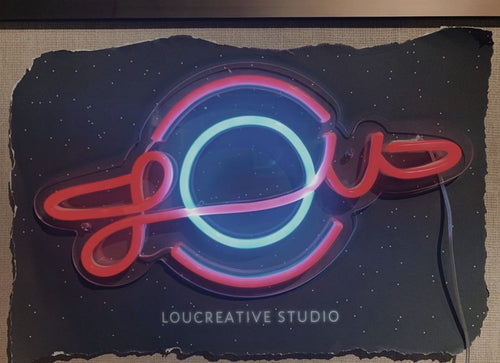Neon signs have long been a staple of eye-catching advertising, urban art, and vibrant storefront displays. Known for their distinctive glow and nostalgic charm, neon signs are more than just decoration—they're functional, durable, and engineered using a combination of specific materials chosen for performance and longevity. But not all neon signs are created equal.
The quality, brightness, efficiency, and lifespan of a neon sign depend largely on the materials used to make it. From the type of glass tubing to the choice of gas inside, and even the coatings and electrical components, every element plays a critical role in how well a neon sign performs over time.
As businesses and designers seek signage that not only looks great but also stands the test of time, understanding the right materials becomes essential. Whether you’re planning to install a sign for your shop, craft custom artwork, or simply curious about how these glowing fixtures are made, this guide is designed to break down the science and practicality behind each material involved.
What Materials Are Best for Making Neon Signs? | Expert Guide
In this guide, we will explain the best materials for making neon signs, supported by real-world data, case studies, and expert recommendations.

1. Glass Tubing: The Core Element
The foundation of every neon sign is its glass tubing. Neon tubes are typically made from soft lead glass or borosilicate glass. Soft lead glass is easier to bend and shape, making it suitable for custom and intricate designs. Borosilicate glass, while more rigid, is highly resistant to thermal shock and chemicals, making it ideal for outdoor or industrial applications. Glass tubes come in standard diameters ranging from 8mm to 15mm. Smaller diameters produce a finer, sharper glow suitable for detailed lettering, whereas larger diameters emit more light and are better suited for large displays. Glass is chosen over plastic or other materials because it withstands high voltage, allows visibility of the glowing gas, and maintains structural integrity under heat and electrical discharge.
2. Gases: What Really Makes It Glow
The gas inside the tube is what creates the iconic glow of neon signs. The two primary gases used are neon and argon. Neon gas emits a bright red-orange color naturally, which is why it's used for red signage. Argon gas, typically mixed with a small amount of mercury, produces a pale blue glow. Other noble gases like krypton and helium are occasionally used for specialty colors. The gas chosen impacts the color and brightness of the light emitted. The glow is generated when a high voltage current excites the gas atoms, causing them to release energy as visible light.
| Gas Type | Emitted Color | Common Usage |
|---|---|---|
| Neon | Red-orange | Standard signage |
| Argon | Pale blue (with mercury) | Multicolor signs |
| Helium | Pale yellow | Scientific displays |
| Krypton | White/green tint | Decorative/experimental |
3. Electrodes: Ensuring Efficiency and Longevity
Electrodes are attached at both ends of the glass tubing and are responsible for conducting electricity into the gas-filled tube. They are typically made of pure iron or nickel and are coated with emissive materials like barium compounds to facilitate electron emission. High-quality electrodes ensure consistent performance and longevity. Properly sealed and well-constructed electrodes prevent air from leaking into the tube, which would otherwise compromise the light output and efficiency. Choosing durable, double-coated electrodes increases the lifespan of a neon sign, often exceeding 10 years with proper usage.
4. Phosphor Coating: Expanding the Color Palette
While neon and argon gases produce limited natural colors, phosphor coatings inside the glass tubes enable a broader color range. These coatings are made from compounds like calcium tungstate, zinc silicate, or rare-earth phosphors. When ultraviolet light from argon-mercury discharge hits the phosphor, it fluoresces, emitting various visible colors. This method allows the creation of green, pink, purple, and other vibrant hues. The quality of the phosphor coating affects color uniformity and brightness. Modern phosphors offer better longevity and are more resistant to fading than earlier generations.
5. Inert Fillers and Mercury Dosing
In signs using argon gas, a small amount of liquid mercury is added to enhance brightness. The mercury vaporizes when the sign is powered, increasing UV light production, which in turn activates the phosphor coating. This process makes mercury-dosed argon tubes more efficient in producing bright colors. However, mercury is a hazardous material and must be handled with care. In many regions, there are strict regulations governing its use and disposal. Some modern systems employ precise mercury dosing machines to limit exposure and ensure consistency. Inert gases themselves are non-toxic and stable, posing minimal risk when used correctly.
6. Support Structures and Mounting Materials
The support structure holds the neon tubing in place and provides stability to the overall sign. Common materials include aluminum backings, acrylic panels, and steel frames. Aluminum is lightweight, corrosion-resistant, and easy to shape, making it a preferred choice for commercial signs. Acrylic offers a transparent, customizable surface ideal for indoor displays. Steel, while heavier, provides maximum durability for large or exposed signs. Mounting clips, standoffs, and brackets are used to secure the tubing. Choosing the right support material ensures the sign maintains its shape, prevents breakage, and facilitates easier installation.
7. Power Supply and Transformers
Neon signs operate using high-voltage transformers that convert standard electrical current into the 3,000 to 15,000 volts required to excite the gas inside the tube. There are two main types of transformers: electromagnetic and solid-state. Electromagnetic transformers are traditional, reliable, and better for long or complex signs. Solid-state transformers are lighter and more energy-efficient but may not handle long tubes as effectively. The length and diameter of the tube, as well as the type of gas used, determine the voltage needed. Safety features such as ground fault protection and thermal overload switches are commonly built into modern transformers.
| Transformer Type | Pros | Cons |
| Electromagnetic | Durable, handles long tubes | Heavier, less efficient |
| Solid-state | Lightweight, energy-efficient | May struggle with longer tubes |
8. Neon vs. LED: A Materials Comparison
With advances in lighting technology, LED neon flex has become a popular alternative to traditional neon. The core differences lie in materials and energy consumption. Traditional neon uses glass tubes filled with gas, while LED flex uses plastic (usually PVC or silicone) with embedded light-emitting diodes.
| Feature | Traditional Neon | LED Neon Flex |
| Tube Material | Glass | PVC or silicone |
| Lighting Source | Electrified gas | Light-emitting diodes |
| Flexibility | Rigid | Highly flexible |
| Energy Efficiency | Moderate | High |
| Longevity | 10-15 years | 30,000-50,000 hours |
| Maintenance | Moderate | Low |
While LED options are more energy-efficient and safer, traditional neon remains unmatched in terms of visual warmth and color purity. The choice depends on the application, budget, and desired aesthetic.
9. Safety and Compliance
Safety in neon sign construction is critical due to the use of high voltage and potentially hazardous materials like mercury. Compliance with local and international standards such as UL 2161 (United States), CE Marking (Europe), and RoHS (Restriction of Hazardous Substances) ensures safe operation. Key safety components include insulated wiring, proper grounding, transformer protection, and secure mounting. Regular inspections and responsible handling of mercury are also essential. In many regions, only certified professionals are allowed to install or repair neon signs.
10. Cost Factors Based on Materials
The cost of a neon sign depends on the materials selected, complexity of the design, and installation requirements. Below is a breakdown of typical material costs per linear foot:
| Material Component | Estimated Cost (per ft.) |
| Glass Tubing | $1.50 – $3.00 |
| Electrodes | $0.50 – $1.00 |
| Gas Filling | $0.20 – $0.40 |
| Phosphor Coating | $0.75 – $1.50 |
| Mercury Dosing | $0.10 – $0.30 |
| Mounting Hardware | $2.00 – $5.00 |
These prices exclude labor, design, and transformer costs. Larger signs or those with intricate detailing will naturally incur higher overall costs. Budget-conscious buyers may opt for LED flex alternatives, which have a different pricing structure but lower operational costs over time.
Frequently Asked Questions
Q1: What type of glass is best for outdoor neon signs? A: Borosilicate glass is preferred for outdoor use due to its resistance to temperature changes and environmental stress.
Q2: Can neon signs be made without mercury? A: Yes, signs using pure neon gas or phosphor coatings can be mercury-free, but color range may be limited.
Q3: How long do neon signs typically last? A: With proper maintenance, neon signs can last 10 to 15 years or more.
Q4: Are neon signs energy-efficient? A: Traditional neon signs are less energy-efficient than LED alternatives, but still viable for static displays.
Q5: Are LED neon signs better than traditional neon? A: LED neon is more energy-efficient and flexible, but traditional neon offers superior color depth and authenticity.
Q6: Is special certification needed to install neon signs? A: In most regions, certification is required due to high-voltage components and mercury handling.
Conclusion: Choosing the Right Materials for Lasting Neon Signs
Creating an effective neon sign requires careful selection of materials, each serving a distinct purpose. Glass tubing forms the structural backbone, while the type of gas used determines the color and intensity of the glow. Electrodes ensure consistent electrical conductivity, and phosphor coatings allow for a broader color palette beyond natural gas emissions. For signs using argon, mercury dosing is essential to amplify brightness, though safety and environmental compliance must be closely observed.
Beyond illumination, support structures like acrylic or aluminum panels provide the durability needed for indoor or outdoor use. A reliable power supply or transformer ensures the system runs safely and efficiently, while modern safety features and certifications protect both installers and users. Comparing traditional neon with LED alternatives, each option offers unique benefits in terms of energy use, cost, and visual effect.
Ultimately, the best material choice depends on your specific goals: whether you value authentic glow, energy savings, long lifespan, or flexibility. Understanding each component helps achieve the perfect balance of performance, aesthetics, and safety.
This comprehensive guide covers everything you need to know about the materials that go into crafting effective, safe, and visually stunning neon signs.




